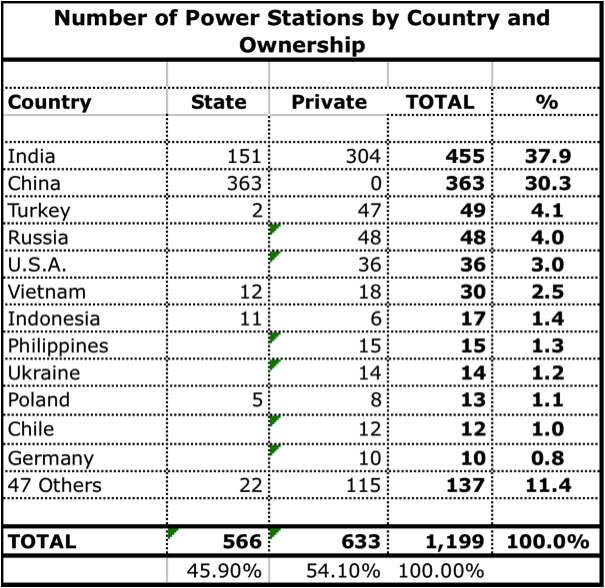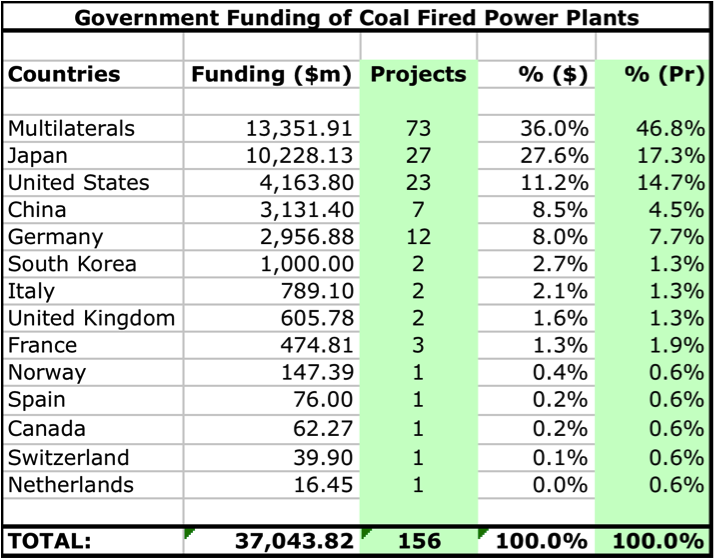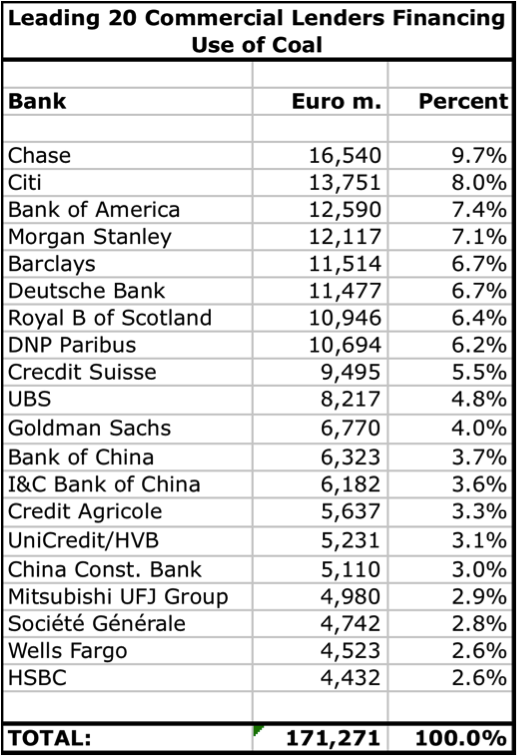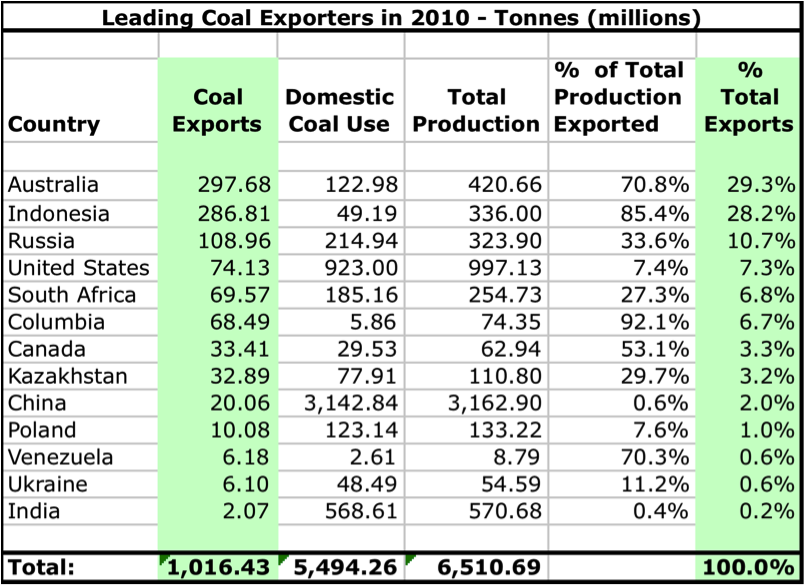
Yang and Cui (2012) have written a carefully researched Paper detailing the funding and increased use of coal likely over the next decade. They show that growing demand for and use of coal seems assured by availability of funding, much of it on concessional terms, to build 1,199 new coal burning power plants. None of these new plants includes carbon capture and sequestration in their design because present technology is prohibitively expensive to use. Consequently all will emit carbon dioxide (CO2) to the atmosphere, accelerating growth in its concentration and global warming.
It is not known how many of these power plants (some may) include flue scrubbers able to effectively prevent aerosol emissions but it seems likely that their operation could significantly increase aerosol pollution. Of concern is that aerosol emissions could result in soot deposits on ice and frozen land surfaces, increasing absorption of solar energy and speeding up melting. This would result in speedier loss of albedo and carbon emissions from degrading permafrost and rise in average global sea level.

Table 1. New coal fired power stations proposed for construction in 59 countries. Details available at Source.
The above table shows that China has a program of building 363 coal-fired power stations. This compares with its program of 28 new nuclear powered plants. It also shows that 818 (68.2%) of all new power plants are to be built by just 2 countries, India and China. In most cases construction approval has been given, by national governments, having regard to the environmental impact of their operation. In the case of State-owned power stations government may be contributing to all or part of the cost of construction or assisting in facilitating funding.

Table 2 shows that multilateral lending institutions, are making loans for construction of ~47% of publicly funded power plants. Source
Not all countries have the resources to fund power plant construction or operation and may seek assistance from multinational agencies. Funding provided by these institutions totals $13,351 million and includes the World Bank Group ($5.13 billion for construction of 29 plants) and the Asian Development Bank ($3.91 billion for 21 plants). These agencies are owned or funded by governments all of which accept the science of global warming, recognize its consequences and have declared their intention of acting to curb greenhouse gas emissions.
As shown in Table 2, other government owned or funded lending institutions (notably export banks) have made $23,692 million available for construction of 83 power plants. The largest of these agencies, the Japan Bank for International Cooperation, is providing $8.13 billion to fund construction of 21 power plants. As with Japan, the governments of other countries providing aid are concerned to reduce greenhouse emissions on the one hand but on the other, they seek to promote their exports and expand their economies. Economic considerations are clearly taking precedence over environmental concerns.

Table 3 shows that in 2010 the largest lenders (€66 bn.) were from the USA, with other lenders from developed countries supporting construction of coal fired power stations. Derived from Source
Table 3 lists the 20 largest commercial banks making loans of €171,271 million for construction of coal fired power plants. These banks are well aware that the plants they are funding will significantly increase carbon emissions but feel that short-term profit outweighs the effects of increased global warming. Unlike national governments, banks have given no undertaking to act in a way which reduces greenhouse gas emissions and curbs global warming. Banks are motivated by profit. Do they need reminding that they also have responsibilities for promoting the public good?
Many of the 1,199 new power plants are located in developing countries that lack an established coal mining industry or one large enough to supply additional coal burning power plants. The result is: It increases the dependence of those countries on imported coal, impacting their foreign currency reserves and reducing their ability to develop and operate social infrastructure. It increases their pollution of the atmosphere at a time when emphasis is on the need to reduce CO2 and aerosol emissions. It delays inevitable adoption by those countries of technology enabling electricity generation from renewable sources, thereby committing them to avoidable expenditure on shorter-term coal-fired energy.

Table 4 shows that 2 countries (Australia and Indonesia) dominate coal exports with 57.5% of total trade. China produced 44% of total world production in 2010. Derived from Source.
Increased demand for coal is supported by ready availability of bank financing to fund new and expanding coal mining operations and building related infrastructure. Mining operations are supported by the governments of coal producing countries and states with subsidies in the form of tax credits, loans or loan guarantees, fuel subsidies, and exemptions from paying or contributing to the social and environmental damage caused by their activities.
The World Bank has produced an authoritative report warning of the present and future dangers posed by global warming and consequential climate change, while funding greater use of coal and pollution of the atmosphere. This dichotomy, funding the very things it and the United Nations properly warn against, is not limited to international funding agencies. It is also true of nations and states or regions within those nations, which, on the one hand, adopt policies and act to reduce emissions causing global warming while at the same time supporting and acting to bring about an increase in those emissions.
An example of this contradiction is seen in Australia. The Australian government has signed and ratified the Kyoto Protocol, long resisted by the previous Coalition government. It has placed a tax on carbon emissions ($23/tonne) and legislated for its conversion to a national cap and trade system in 2015. Parliament has adopted a bi-partisan target of generating 20% of its energy needs from renewable sources by 2020. It has legislated policies and established institutions to invest billions in development of renewable energy technology and its application over this decade. By offering government subsidies, over a million households have been encouraged to use photovoltaic cell displays to meet domestic energy needs.
Impressive? Well, yes ..... and no.
Australia is the worlds’ largest coal exporter (see Table 4) and seems intent on maintaining that position through an impressive investment pipe-line in coal mining. The latter includes pending development of mega-coal mines in the Galilee Basin, the largest in the world. Development and expansion of coal mining is supported by ready approval of mining licenses by Federal and State governments. Mining activity is further supported by rapid approval of infrastructure and other development proposals as well as government subsidies, notably waiving taxes on diesel fuel for all off-road operations.
Why all this assistance? In the words of the Minister for Climate Change (who represents a coal mining constituency) to protect the jobs of those employed by the mining industry. The Federal government benefits from additional company tax and tax on the income of employees. State Premiers support increased coal mining because it boosts their revenue through Royalty payments made by companies engaged in mining. The fact that Australian coal is exported for the sole purpose of burning it, emitting CO2 to the atmosphere and significantly contributing to global warming is ignored and proves no impediment to coal mining expansion.
Per-capita, Australia remains the largest CO2 emitter in the world and, unless it rapidly expands its population, is likely to maintain that position. In 2000 its domestic emissions were 565 megatonnes of CO2-e. Australia has committed to reduce these emissions by 5% so one would think emissions would fall to 537 megtonnes in 2020. Not so. The Australian government has stated that 2020 projected domestic emissions are 693 megatonnes and will fall by 55 to 638 megatonnes. That is, between 2000 – 2020 domestic emissions are expected to rise from 565 to 638 megatonnes, an increase of 73 megatonnes.
Why this sleight of hand with the nations emissions “reduction” target? If the target of generating 20% of the nations energy needs from renewable sources by 2020 remains unchanged and is achieved, a reduction of more than 5% in domestic CO2 emissions could be realised. With market pricing of carbon under the legislated cap and trade scheme it is unlikely that this would seriously impact or disadvantage the Australian economy. Government commitment to a real reduction of domestic emissions and the adequacy of its 2020 reduction target should be questioned.
At a time when it is necessary to curb CO2 emissions, multilateral funding agencies and national governments are acting to increase them, while publicly recognizing and decrying the consequences of doing so.
Yang and Cui (2012) identify governments and lending institutions responsible for promoting and aiding increased burning of coal and the magnitude of their funding. Their findings raise a number of questions, not least of which are:
The answer to the question, who is paying for the consequences of burning so much additional coal is easy to answer. Everyone and everything on the planet. Broadly we know the consequences of increased CO2 in the atmosphere and knowing this, should we not ask ourselves why this folly is being aided and abetted by, of all organizations, the United Nations and its member countries?
Posted by Riduna on Wednesday, 8 May, 2013
 |
The Skeptical Science website by Skeptical Science is licensed under a Creative Commons Attribution 3.0 Unported License. |